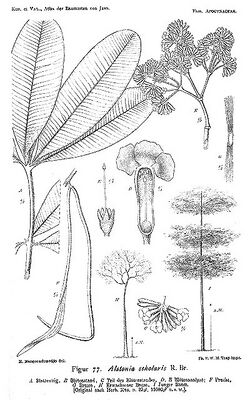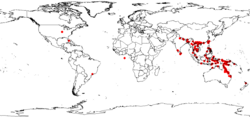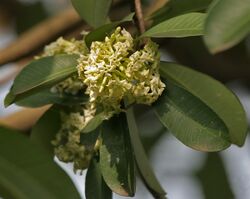Biology:Alstonia scholaris
| Alstonia scholaris | |
|---|---|

| |
| Blackboard tree (Alstonia scholaris) | |
| Scientific classification | |
| Kingdom: | Plantae |
| Clade: | Tracheophytes |
| Clade: | Angiosperms |
| Clade: | Eudicots |
| Clade: | Asterids |
| Order: | Gentianales |
| Family: | Apocynaceae |
| Genus: | Alstonia |
| Species: | A. scholaris
|
| Binomial name | |
| Alstonia scholaris | |

| |
| Occurrence data from GBIF[2] | |
| Synonyms[3] | |
| |
Alstonia scholaris, commonly called blackboard tree, scholar tree, milkwood or devil's tree in English,[3] is an evergreen tropical tree in the Dogbane Family (Apocynaceae). It is native to southern China, tropical Asia (mainly the Indian subcontinent and Southeast Asia) and Australasia, where it is a common ornamental plant. It is a toxic plant, but is used traditionally for myriad diseases and complaints.
Description
Alstonia scholaris is a glabrous tree and grows up to 40 m (130 ft) tall. Its mature bark is grayish and its young branches are copiously marked with lenticels. A unique feature of this tree is that in some places, such as New Guinea, the trunk is three-sided (i.e. it is triangular in cross-section).[4]
The upper side of the leaves are glossy, while the underside is greyish.[5] Leaves occur in whorls of three to ten; petioles are 1–3 cm (0.39–1.18 in); the leathery leaves are narrowly obovate to very narrowly spathulate, base cuneate, apex usually rounded and up to 23 cm (9.1 in) long by up to 8 cm (3.1 in) in width.[6] lateral veins occur in 25 to 50 pairs, at 80–90° to midvein. Cymes are dense and pubescent; peduncle is 4–7 cm (1.6–2.8 in) long. Pedicels are usually as long as or shorter than calyx. The corolla is white and tube-like, 6–10 mm (0.24–0.39 in); lobes are broadly ovate or broadly obovate, 2–4.5 mm (0.079–0.177 in), overlapping to the left. The ovaries are distinct and pubescent. The follicles are distinct and linear.
Flowers bloom in the month October. The flowers are very fragrant similar to the flower of Cestrum nocturnum.
Seeds of A. scholaris are oblong, with ciliated margins, and ends with tufts of hairs 1.5–2 cm (0.59–0.79 in).[7] The bark is almost odorless and very bitter, with abundant bitter and milky sap.
Distribution
Alstonia scholaris is native to the following regions:[3]
- China: Guangxi, Yunnan
- Indian subcontinent: Bangladesh, India, Nepal, Pakistan, Sri Lanka
- Southeast Asia: Cambodia, Laos, Indonesia, Malaysia, Myanmar, Papua New Guinea, Philippines, Thailand, Vietnam[8]
- Australia: Queensland
Alstonia scholaris is the state tree of West Bengal, India, where it is called Chhatim tree.
Toxicity
This is a toxic plant. At high doses, an extract of the plant exhibited marked damage to all the major organs of the body in both rats and mice. The toxicity appears to depend on the plant organ studied, as well as the season it is harvested, with the bark collected in the monsoon season being the least toxic, and bark in the summer the most. Intraperitoneal administration is much more toxic than oral. Rats were more susceptible to the poison than mice, and pure-bred mice strains were more susceptible than crossbred. The toxic effects may be due to the echitamine content of the bark, an alkaloid.[9]
Uses
The wood of Alstonia scholaris has been recommended for the manufacture of pencils, as it is suitable in nature and the tree grows rapidly and is easy to cultivate.[10] In Sri Lanka its light wood was used for coffins. The wood close to the root is very light and of white colour, and in Borneo was used for net floats, household utensils, trenchers, corks, etc.[11] In Theravada Buddhism, the first Buddha is said to have used Alstonia scholaris as the tree for achieving enlightenment.
The 1889 book The Useful Native Plants of Australia states that "the powerfully bitter bark of this tree is used by the natives of India in bowel complaints (Treasury of Botany). It has proved a valuable remedy in chronic diarrhoea and the advanced stages of dysentery. It has also been found effectual in restoring the tone of the stomach and of the system generally in debility after fevers and other exhausting diseases (Pharmacopoeia of India). It is described in the Pharmacopoeia of India as an astringent tonic, anthelmintic, and antiperiodic. It is held in the highest repute in the Phillippine Islands [sic]."[12] Despite its widespread traditional use as an 'antiperiodic' (a medicine which was supposed to cure the effects of malaria), it was found to have little to very weak activity against Plasmodium falciparum.[13][14] It had no effect against Giardia intestinalis,[13] and weak effect against Entamoeba histolytica, which both cause diarrhoea.[14]
During convocation the leaves of Alstonia scholaris (saptaparni) are awarded to graduates and postgraduates of Visva-Bharati University by the chancellor, given to him in turn by the Prime Minister of India. In recent years, supposedly to prevent excessive damage to the environment, the vice-chancellor of the University accepts one saptaparni leaf from the chancellor on behalf of all the students. This tradition was initiated by the founder of the University, Rabindranath Tagore.[15]
At one time, decoctions of the leaves were used for beriberi.[5]
Chemistry
The bark contains the alkaloids ditamine, echitenine,[citation needed] echitamine[9] and strictamine.[16] Echitamine is the most important alkaloid found in the bark, as it has been detected in all samples studied and collected from several locations, and which is commercially sold as herbal medicine.[17]
Gallery
References
- ↑ Lakhey, P.; Pathak, J. (2021). "Alstonia scholaris". IUCN Red List of Threatened Species 2021: e.T32295A2812825. https://www.iucnredlist.org/species/32295/2812825. Retrieved 11 November 2022.
- ↑ GBIF.org (07 June 2018) GBIF Occurrence Download https://doi.org/10.15468/dl.eokqvq Alstonia scholaris (L.) R.Br.
- ↑ 3.0 3.1 3.2 {{citation | mode = cs1 | title = Alstonia scholaris | work = Germplasm Resources Information Network (GRIN) | url = | publisher = [[Organization:Agricultural Research ServAgricultural Research Service (ARS), United States Department of Agriculture (USDA) | access-date = 2012-03-30 }}
- ↑ Lane-Poole, C.E. (1925). Forest Resources of the Territories of Papua and New Guinea. Melbourne: Government Printer. p. 134.
- ↑ 5.0 5.1 "Dita / Alstonia scholaris / WHITE CHEESE WOOD / Tang jiao shu /: Philippine Medicinal Herbs / Philippine Alternative Medicine". http://www.stuartxchange.org/Dita.html.
- ↑ Corner, Prof. E.J.H. (1952). Wayside Trees of Malaya - Volume 1. Singapore: Govt Printing Office. p. 141.
- ↑ "Alstonia scholaris". http://www.efloras.org/florataxon.aspx?flora_id=2&taxon_id=200018323.
- ↑ Simon Gardner, Pindar Sidisunthorn and Lai Ee May, 2011. Heritage Trees of Penang. Penang: Areca Books. ISBN:978-967-57190-6-6
- ↑ 9.0 9.1 Baliga, Manjeshwar Shrinath; Jagetia, Ganesh Chandra; Ulloor, Jagadish N.; Baliga, Manjeshwar Poonam; Ponemone, Venkatesh; Reddy, Rosi; Rao, Mallikarjun K. V. N.; Baliga, Shivanada Bantwal et al. (2004). "The evaluation of the acute toxicity and long term safety of hydroalcoholic extract of Sapthaparna (Alstonia scholaris) in mice and rats". Toxicology Letters 151 (2): 317–326. doi:10.1016/j.toxlet.2004.01.015. PMID 15183456. http://eprints.manipal.edu/314.
- ↑ Tonanont, N. Wood used in pencil making. Vanasarn 1974 Vol. 32 No. 3 pp. 225–227
- ↑ Grieve, M. (1931). "Alstonia". A Modern Botanical. http://www.botanical.com/botanical/mgmh/a/alsto028.html. Retrieved 29 June 2007.
- ↑ J. H. Maiden (1889). The useful native plants of Australia : Including Tasmania. Sydney: Turner and Henderson. https://primo-slnsw.hosted.exlibrisgroup.com/primo-explore/fulldisplay?docid=SLNSW_ALMA21105097830002626&context=L&vid=SLNSW&search_scope=EEA&tab=default_tab&lang=en_US.
- ↑ 13.0 13.1 Wright, Colin W.; Allen, David; Phillipson, J. David; Kirby, Geoffrey C.; Warhurst, David C.; Massiot, Georges; Le Men-Olivier, Louisette (September 1993). "Alstonia species: are they effective in malaria treatment?". Journal of Ethnopharmacology 40 (1): 41–45. doi:10.1016/0378-8741(93)90087-L. PMID 8246529.
- ↑ 14.0 14.1 Wright, C. W.; Allen, D.; Cai, Ya; Phillipson, J. D.; Said, I. M.; Kirby, G. C.; Warhurst, D. C. (June 1992). "In vitro antiamoebic and antiplasmodial activities of alkaloids isolated from Alstonia angustifolia roots". Phytotherapy Research 6 (3): 121–124. doi:10.1002/ptr.2650060303.
- ↑ Abhishek Gulshan (22 October 2019). "Why the Saptaparni is called the devil's tree". The Hindu. https://www.thehindu.com/sci-tech/energy-and-environment/why-the-saptaparni-is-called-the-devils-tree/article29767114.ece.
- ↑ Bhattacharya, S. K.; Bose, R.; Dutta, S. C.; Ray, A. B.; Guha, S. R. (1979). "Neuropharmacological studies on strictamine isolated from Alstonia scholaris". Indian Journal of Experimental Biology 17 (6): 598–600. PMID 500142.
- ↑ Yamauchi, Tatsuo; Abe, Fumiko; Padolina, William G.; Dayrit, Fabian M. (1990). "Alkaloids from leaves and bark of Alstonia scholaris in the Philippines". Phytochemistry 29 (10): 3321–3325. doi:10.1016/0031-9422(90)80208-X. Bibcode: 1990PChem..29.3321Y. https://www.academia.edu/7426110. Retrieved 1 July 2021.
Wikidata ☰ Q135307 entry
 |








